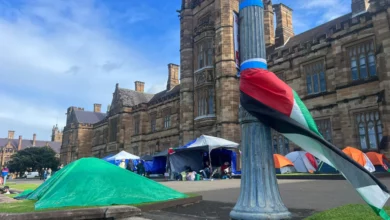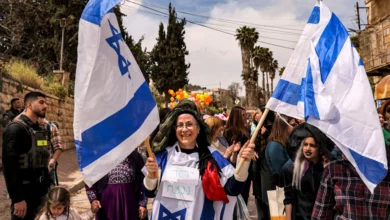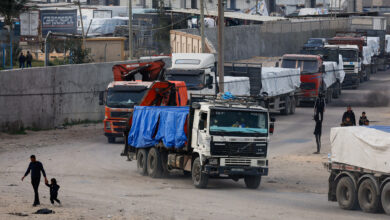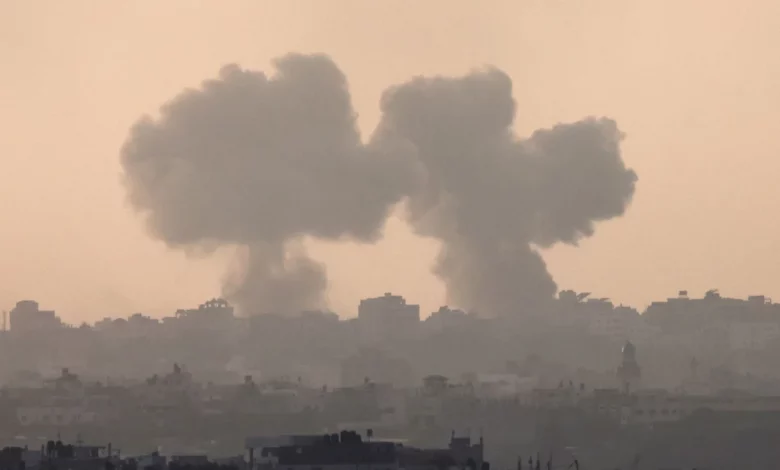
Overnight strikes on Sunday appeared to be the most sustained bombardment of northern Gaza in the past two weeks, according to a CNN team on the ground in southern Israel, and come as the Israel Defense Forces (IDF) prepares for a potential large ground operation, with huge numbers of troops and tanks amassed at the border.
At least 26 people were killed in Israeli strikes on the Jabalia refugee camp – one of the largest in Gaza – the director of the Indonesian Hospital in Gaza, Atef Al Kahlout told CNN. In the southern city of Rafah, 29 people were killed after four houses were struck, according to the Hamas-controlled Ministry of Health in Gaza spokesperson Ashraf Al Qidra.
The bombs hit buildings in Rafah, Khan Younis, central Gaza and Gaza City, including homes, the Palestinian Interior Ministry in Gaza said. The IDF said on Sunday night that it struck “dozens of Hamas terror targets in Gaza,” without clarifying further.
The Israeli siege and near-constant bombing of Gaza in response to the October 7 murder and kidnap rampage by Hamas has leveled entire neighborhoods, including schools and mosques, and devastated the already insufficient health care system.
Amid a weekend of ramped up strikes, doctors described “catastrophic” conditions at one central Gazan hospital as electricity and fuel supplies run out and crippled medical facilities rapidly become overwhelmed with casualties.
Dr. Iyad Issa Abu Zaher, director general of Al Aqsa Martyrs hospital in Gaza, described a “bloody day” for his staff to CNN on Sunday, saying the hospital had received up to 166 bodies and more than 300 injured people.
“It’s impossible for any hospital in the world to admit this number of injured,” he said.
Videos obtained by CNN showed the hospital receiving more than a dozen bodies wrapped in shrouds, while grieving family members tried to identify them.
At another Gaza hospital, doctors have warned that most of the critically ill infants relying on ventilators in the neonatal unit will die if the electricity supply is interrupted.
“If the electricity is stopped, there will be catastrophic events inside this unit,” said Dr. Fu’ad al-Bulbul, head of the neonatal department Unit at Al-Shifa hospital in Gaza, in a video released by the Health Ministry in Gaza.
“We can save only one [or] two babies but, we cannot save all babies.”
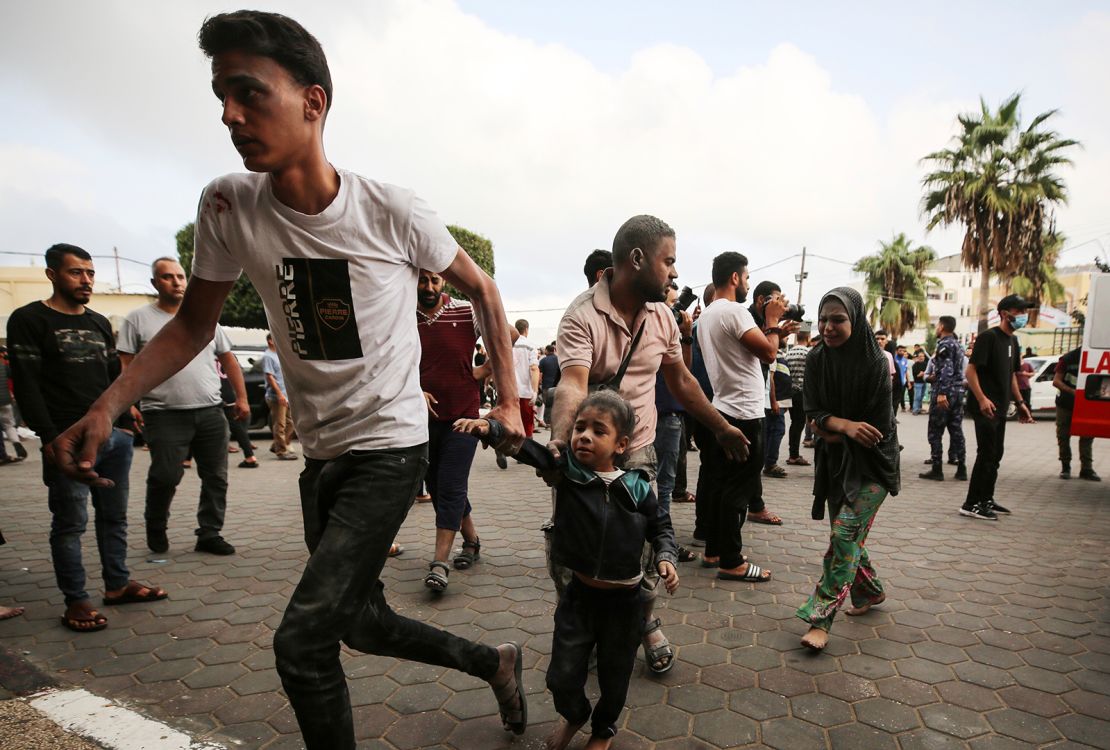
Life-saving medicines to keep preterm babies alive are perilously low and the exhausted medical team is overwhelmed with the number of sick babies, he said.
A small glimmer of hope to alleviate some of the suffering came in the form of two separate humanitarian convoys over the weekend, crossing the Rafah border crossing with Egypt with at least 34 trucks carrying food, water, medicine and medical supplies.
However, the trucks did not bring in fuel, which is vital for running hospitals and treating water in the isolated territory, according to United Nations Relief and Works Agency (UNRWA) spokesperson Juliette Touma. Israel has said that fuel would be purloined by Hamas.
Aid workers and international leaders have warned that the supplies are insufficient to combat the “catastrophic” humanitarian situation in Gaza that is home to more than 2 million people. The Palestine Red Crescent Society said it is a “drop in the ocean” of what is needed.
Rising death toll
As of Sunday, Israeli airstrikes have killed at least 4,651 people in Gaza, including more than 1,900 children, according to the Health Ministry in Gaza. At least 14,245 people have been wounded, it added.
That toll is expected to rise as Israel’s military ramps up its aerial bombardment of Gaza.
Over the weekend, Israel called once again for civilians to leave northern parts of the strip – a warning that was condemned by the World Health Organization and which the Palestinian Red Crescent said amounted to a “death penalty for patients.”
IDF chief of staff Herzi Halevi told commanders Saturday that the military is preparing to “enter the Gaza Strip” and “destroy Hamas operatives and infrastructures,” but offered no timeline for the possible ground offensive.
On Sunday, Hamas and Israeli forces engaged in limited clashes inside Gaza – in what is believed to be one of the first significant skirmishes on the ground inside the strip since the Islamist militants’ October 7 attack on Israel that killed more than 1,400 people, mostly civilians.
An IDF soldier was killed and three others were wounded during an operation in the area of Kibbutz Kissufim near Gaza on Sunday, according to IDF spokesperson Daniel Hagari. Earlier, Hamas said its fighters had destroyed two Israeli military bulldozers and a tank in an ambush near the Gazan city of Khan Younis, forcing Israeli troops to retreat without their vehicles.
‘No ceasefire’
The United States and its allies have urged Israel to be strategic and clear about its goals during any ground operation in Gaza, warning against a prolonged occupation and placing a particular emphasis on avoiding civilian casualties, although the past two weeks has already seen more people killed in Gaza than during any previous conflict with Israel.
The mounting death toll has sparked growing protests across the Middle East and further afield as social media fills with imagery of the devastation Gazans are living through.
On Sunday, US President Joe Biden made a flurry of calls to world leaders, including Israeli Prime Minister Benjamin Netanyahu, about the ongoing conflict and amid efforts by US officials seeking to keep it from widening.
The White House said Netanyahu and Biden “affirmed there will now be a continued flow” of humanitarian assistance to Gaza during their call.
CNN previously reported that the Biden administration has pressed Israel to delay its imminent invasion of Gaza to allow for the release of more Hamas hostages and aid into the enclave.
However, a senior Israeli official told CNN Sunday there will be “no ceasefire” in Gaza, despite US and Qatari efforts to free more than 200 hostages held there by Hamas.
The official said they were “not aware” of US calls for a delay to the Gaza ground operation. The official added that both Israel and the US want all the hostages released “as quickly as possible” but said “humanitarian efforts cannot be allowed to impact the mission to dismantle Hamas.”
Wider conflict
As Israel readies its troops around Gaza, its military has also been engaged in flare ups elsewhere, with increasing violence in the occupied West Bank and on its northern border with Lebanon.
Late Sunday, the IDF said it struck two cells belonging to the Lebanon-based Hezbollah, an Iran-backed paramilitary movement, on the Lebanese side of the border, which it said had planned to launch attacks on Israel.
Netanyahu warned Sunday that if Hezbollah decides to enter the war, it will be crippled “with a force [it] cannot even imagine.”
The occupied West Bank has seen Israeli raids and the arrest of dozens of alleged Hamas members.
On Sunday, the IDF launched an airstrike on the Al-Ansar mosque in the West Bank refugee camp of Jenin, which it said was being used by militant groups to plan for “an imminent terror attack.”
It would not say whether the strike came from a jet, in what would be the first fighter jet strike in the West Bank in nearly two decades.
This is a developing story and will be updated.


